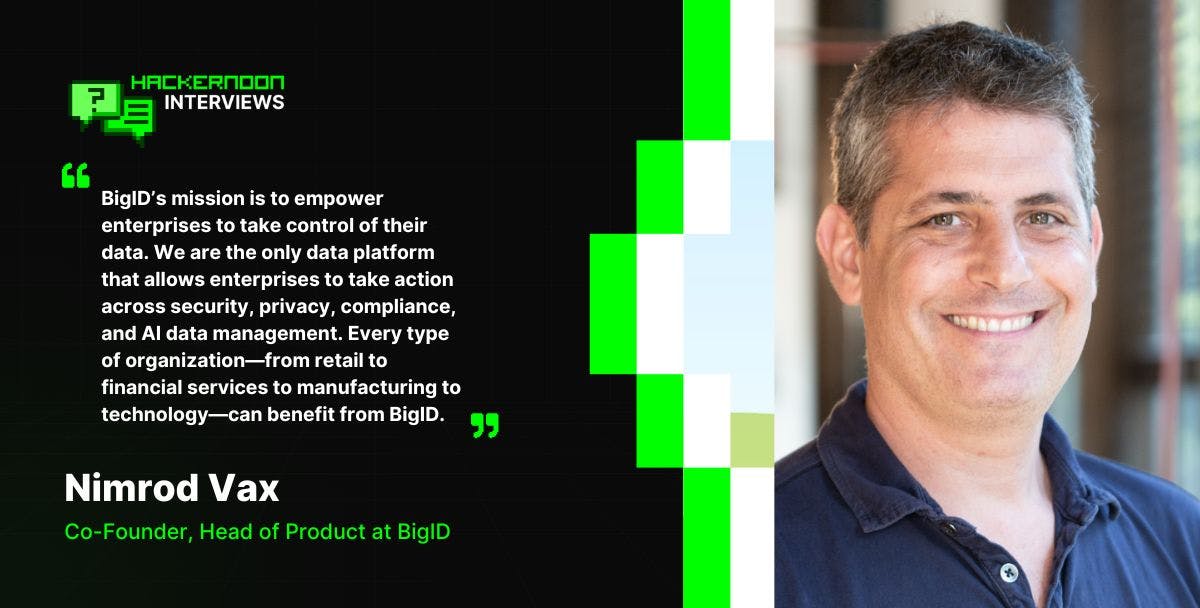10 Questions with Nimrod Vax, Co-Founder, Head of Product at BigID via [The Startup Founder Interview Template].
HackerNoon: What is your company in 2–5 words?
Nimrod Vax: AI-augmented data security, compliance, and privacy.
Why is now the time for your company to exist?
NV: When Dimitri Sirota and I co-founded BigID in 2016, we had witnessed significant data breaches at large companies for years. We saw the devastating impact they had on individuals and organizations. There was no one helping organizations understand the data they had, and they were taking that a step further to help them prevent breaches. That’s the pain point BigID was born from, and more than eight years later, the problem is more prevalent in organizations than ever. This is in large part due to the fact that IT infrastructure is expanding and new threat vectors are emerging, all of which are then compounded by evolving regulatory considerations. This perfect storm makes BigID’s platform mission-critical for organizations to succeed. Built with robust measures from the start, BigID’s platform makes it easy for organizations of any size with stringent security requirements to understand their data and how to protect it before any insider risks or breaches occur.
What do you love about your team, and why are you the ones to solve this problem?
NV: Everyone at BigID is enthusiastic about the work that we do. Our team cares deeply about the products we bring to market and the customers we serve. We’re changing the way companies of all sizes manage their data - with innovative AI that nobody else has, starting with the data first (not the other way around, as traditional security solutions do). We’re also building an open ecosystem to enrich and extend the modern tech stack while building a company based on respect and innovation, not just in the tech itself, but in creating a more diverse and inclusive environment for people to learn, grow, and challenge the status quo.
If you weren’t building your startup, what would you be doing?
NV: I would build a different startup. When I left my last job at CA, I was determined to build my own company. I had emerged in innovation from the beginning of my professional career and felt it was time for me to do it on my own. I’m a product person and derive my satisfaction from building stuff.
At the moment, how do you measure success? What are your metrics?
NV: Our success metrics for product and engineering are circled around one North Star metric: true product adoption, which measures the value creation activity in the product through telemetry. We also have support KPIs for product quality and time to value (time to adoption).
In a few sentences, what do you offer to whom?
NV: BigID’s mission is to empower enterprises to take control of their data. We are the only data platform that allows enterprises to take action across security, privacy, compliance, and AI data management. Every type of organization—from retail to financial services to manufacturing to technology—can benefit from BigID.
What’s most exciting about your traction to date?
NV: We recently achieved centaur status, passing $100M in ARR, which is a remarkable achievement. We're also seeing significant traction and interest in utilizing BigID to manage and secure AI, including generative AI, AI adoption, and all other aspects of AI. This not only demonstrates product-market fit but also future suitability.
Where do you think your growth will be next year?
NV: We have been featured on the Inc. 5000 list for four consecutive years and have also made the Deloitte 500 list about the same number of times, showing no signs of slowing down.
Tell us about your first paying customer and revenue expectations over the next year.
NV: One of our first customers was (and still is) a well-known global retailer and manufacturer. We established a strong relationship with their chief privacy officer and gained deep insights into their privacy and data challenges. The CPO was the first to point out the absence of technology in the privacy sector and the necessity of data mapping for privacy. At that time, privacy became a catalyst for a larger conversation around data-centric approaches throughout the organization. It was a pivotal moment for us, as we realized our unique strengths and focused on the data itself, and the wide range of use cases it enables.
What’s your biggest threat?
NV: Our biggest threat is the amount of unprotected data that is out there and the lack of education about what organizations should do to protect their employees and customers from a breach. With the influx of AI tools, it is also important to highlight the threat of data provenance and model lineage for AI systems. As more companies leverage genAI and LLMs that are trained on massive datasets, it becomes harder to understand where the data learning originated from. This can exacerbate issues like bias, unfairness, and privacy risks if sensitive training data is used without consent or oversight. In order for this threat to be lowered, enterprises need stronger mechanisms for tracing data and model inputs, monitoring drift over time, and auditing how decisions are reached. Even with the best of intentions, AI systems will be difficult to govern if we lose sight of where the knowledge and assumptions are coming from.
This startup founder interview template is based on HackerNoon Founder & CEO David Smooke’s ten questions for startup founders.
Would you like to take a stab at answering some of these questions? The link for the template is HERE.

